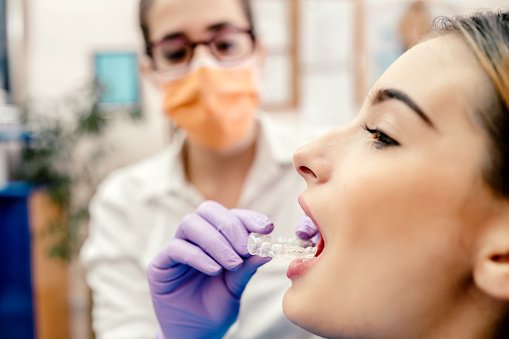Straight Teeth With invisible Braces

Invisible braces are now a very popular orthodontic remedy amongst many patients because they are much less visible and more discreet than regular metal braces. Invisible aligners allow you to maintain a happy smile with as little exposure to metal as possible without the usage of brackets. The technology behind invisible aligners is so advanced that they can be applied and removed very easily, even when in the mouth. A removable plastic aligner (which fits securely around your teeth) is then placed directly over the invisible aligner base. In the majority of cases, this is done during the night while the patient is asleep. Kindly visit this website: https://www.dictionary.com/browse/orthodontics for more useful reference.
Although invisible braces can be very effective for correcting many different aspects of the alignment of your teeth, some situations require completely different solutions. For example, braces for straightening mild to moderate crooked teeth. This requires a different solution than that of those for straightening severe crooked teeth. Typically, if you wish to treat severe crooked teeth you will require traditional braces - either brackets or metal brackets - that will be made to custom fit your teeth. Braces for straightening mild to moderate crooked teeth are much easier to remove.
In the case of severe overbite or underbite, it may be necessary for you and your orthodontist to consult about a bridge or an implant. If you have an overbite or underbite that causes you discomfort or makes it difficult for you to smile then you may well benefit from straightening your teeth with invisible braces. There are options available that include a full upper jaw reconstruction with implants or dentures, and this can often provide a better cosmetic result than traditional braces alone. It is important to understand that straight teeth with implants will not look as good as crooked teeth - they will be far more subtle and the appearance of them may be more subtle than that of a straight smile with dentures. Your orthodontist can advise you of the best way forward in this situation.
If your teeth are too over-bites or undersized, then your orthodontist may recommend that you get fitted for clear aligners. Clear aligners are custom-made aligners that are made to fit each individual tooth in the mouth so that when you smile they are perfectly even and there are no gaps in the alignment. They can also help to prevent the formation of 'bite-marks' on your cheeks and lower teeth. Depending on your orthodontist's recommendations clear braces may be used for up to two years, although some will recommend that they be used for up to six months.
At home treatments are very popular and among the most popular types of braces today. These can range from using invisible braces to clear aligners to a variety of different mouth guards. Some of these treatments are removable, while others are permanent. At home treatments are usually very simple and can involve only a few changes to your diet and oral hygiene routine. However, many patients find that orthodontists are increasingly using high tech appliances and oral retainer devices as part of their treatment. Many dentists offer a full range of options for patients who want to improve their smile.
To keep your straight teeth and improve your smile you must follow your orthodontist's treatment plan. In order to maintain your white, healthy smile you will need to make sure that you have the necessary dental care and you will need to make sure that you do not skip any appointments. Invisible braces can be used in conjunction with clear braces to help you achieve your goals. However, if your orthodontist does not recommend the use of invisible braces then you may want to consider other options to straighten your teeth.
